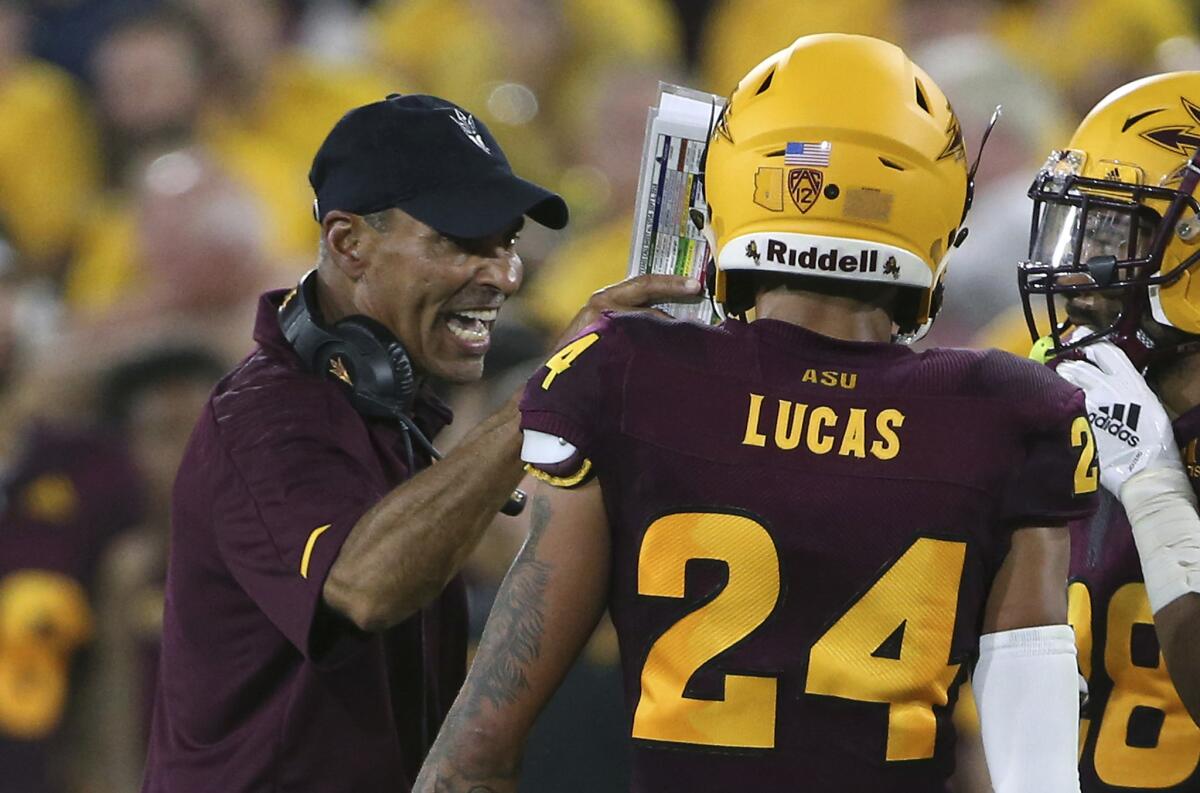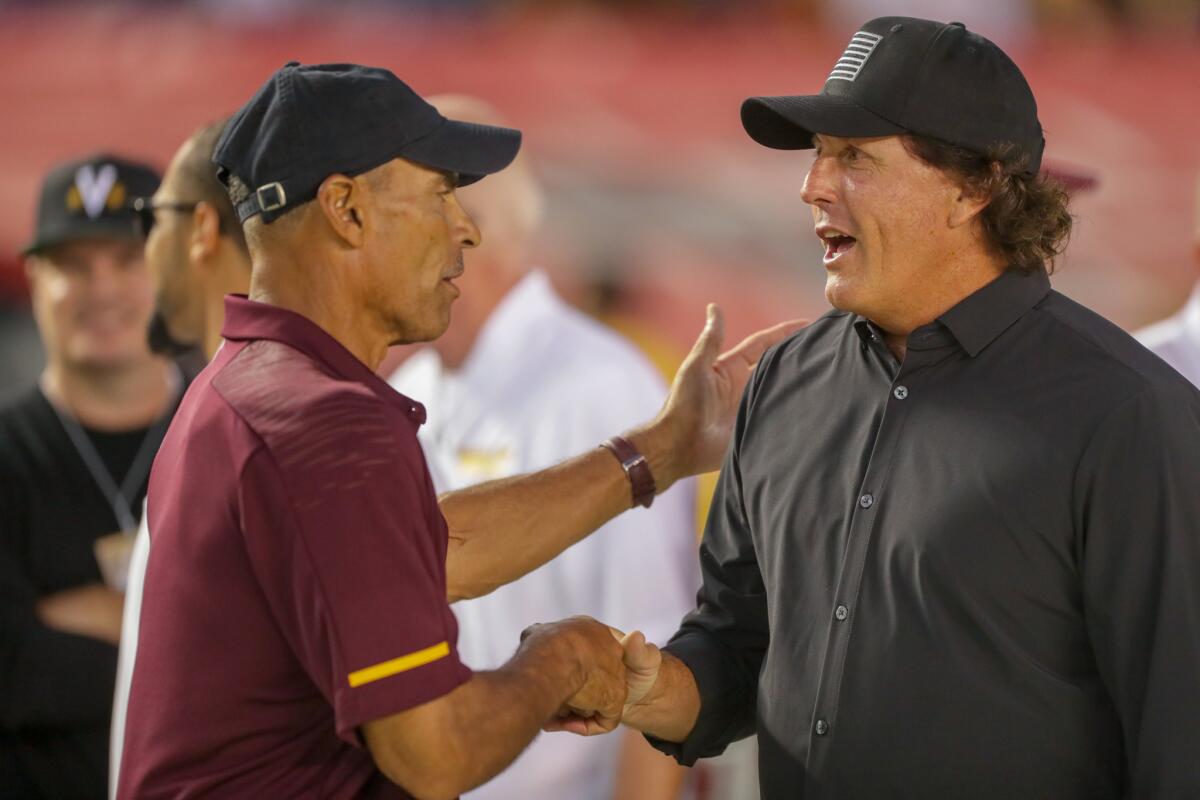Herm Edwards’ return to coaching at Arizona State has been a ‘blast’

- Share via
Reporting from Tempe, Ariz. — Just because Herm Edwards agrees to sit down for an interview, it doesn’t mean he will actually sit down.
Dressed in shorts and a sweatshirt with the sleeves tugged up, the 64-year-old coach flashes a move from his cornerback days as he darts across the office to retrieve a laminated card that lists his down-to-the-minute practice schedule.
Then he rushes to the window, pointing down the street to the condominium where he lives.
A few minutes later, he rolls a dozen or so feet backward in his chair to demonstrate exactly how he likes to observe the locker room after games, watching his players celebrate a win.
“I’m having a blast,” he says. “This is what I was meant to do.”
Last winter, the college football world scratched its head when Arizona State hired this frenetic man to revive its program. To say he was an unexpected choice would be an understatement.
Edwards had spent most of the previous decade working as a television analyst. His NFL coaching days were a distant memory and the last time he worked at the college level, President Reagan was in the White House.
“People said, ‘What? Why are they doing that?’ ” he recalls. “I understand. I get it.”
Though the Sun Devils have begun the season in respectable fashion, their 2-2 record including an upset victory over then-No. 15 Michigan State and a close loss at then-10th-ranked Washington, Edwards doesn’t pretend to have convinced the doubters.
His hiring is part of an experiment, a scheme cooked up by a school president and athletic director grown tired of scrambling for something better than mediocrity in the Pac-12 Conference. The outcome remains far from decided.
“This is something,” Edwards says, “a little outside the box.”

The news release was part of the problem.
When Arizona State brought Edwards aboard in December, the university issued a lengthy statement that touted a “New Leadership Model” with phrases that don’t normally relate to football.
Collaborative approach. Resource allocation. Strategic planning.
“Our goal for this football program is to reach unprecedented heights, and therefore we need to find a way to operate more innovatively and efficiently than we have in the past,” athletic director Ray Anderson said. “In the spirit of innovation, our vision for this program is to have a head coach who serves as a CEO and central leader of a collaborative staff … ”
Somewhere beneath this corporate-speak — which elicited considerable snickering — lay a tangible notion.
The Sun Devils had cycled through four coaches and too many .500 seasons over the last two decades, always a step behind such conference rivals as USC, Stanford and Washington. Their 2017 recruiting class ranked well down the list nationally with no incoming freshmen from talent-rich Southern California, just an hour’s flight away.
“It became clear we could not break out of mediocrity in the Pac-12,” Anderson said this week. “We had to do something different.”
And they had to do it quickly, because donors had ponied up $307 million for a stadium renovation and a sleek, new training center.
In discussions, Anderson and university President Michael Crow decided to stop “trying the same old thing” — as Crow put it — meaning the traditional college model of the all-powerful coach. Borrowing from the NFL, they created the equivalent of a separate general manager and a player personnel director to oversee recruiting.
The coach would still participate in all facets of the program but would focus on preparing his players and making in-game decisions.
“A lot of them want to micromanage it all,” Anderson said. “Unless you’re Nick Saban or a few others … it’s hard to do in this day and age.”
Firing previous coach Todd Graham, the Sun Devils made their intention clear to candidates interested in the opening.
“This isn’t going to be the traditional ‘come in and have full control,’ ” Anderson told them. “Because that doesn’t work here.”
In his playing days, back at California and then San Diego State, Edwards had a sense of flash, “spatting” his shoes with white tape and rubbing Vaseline on the black leather parts.
“So they would shine,” he says, adding: “I don’t know if I was cocky, but I was confident.”
His decade in the NFL — mostly with the Philadelphia Eagles — will always be remembered for a 1978 scoop-and-score fumble recovery in the final seconds against the New York Giants, a play credited with popularizing the “victory” formation at game’s end.
San Jose State hired him as an assistant in 1987, after which he jumped back to the pros for the next two decades, ultimately serving as head coach of the New York Jets and Kansas City Chiefs.
His fiery nature — those fierce eyes, that razor-cropped hair and tight mustache — produced more than a few memes, including the time he leaned across the lectern and glared at a reporter, proclaiming: “You play to win the game.”
So it made sense that, when the Chiefs fired him in early 2009, Edwards transitioned into broadcasting as an analyst covering the NFL and the Southeastern Conference.
If some people thought he lost touch with the game over the next nine-plus years, he insists they were wrong.
“They see you on an hourlong television show … they don’t see everything else you do,” he says. “I was gone from home 170, 180 days a year, studying tape, watching games and going to spring practices at colleges.”
Edwards took notes on what he saw, especially at winning schools. He coached top high school recruits for a week each year at an all-star game, observing the change in young athletes.
“Coaches used to tell them what to do, how to do it and why,” he says. “Now the ‘why’ is first. They want that information.”
The whole time, Edwards insists he was waiting for the right opportunity. Something on the West Coast. A university committed to making football successful.
When Arizona State called last winter, he saw a team that had a reliable quarterback and a top-notch receiver in N’Keal Harry but had struggled to a 7-6 record. The defense was young and thin.
Still, his years in the NFL made him comfortable with the Sun Devils’ new structure and he recalls thinking, “If I’m going to go, I’d better go now.”
Perceptionwise, it didn’t help that he replaced a media favorite in Graham. The odd news release raised further doubts, as did the fact that Anderson was Edwards’ friend and former agent.
The offensive and defensive coordinators, conspicuously retained from Graham’s staff, soon departed, one for a coaching job elsewhere, the other for health reasons.
At a clumsy introductory news conference, Edwards preached to the room — “You don’t forget how to coach” — and, when asked a question by a reporter from Devils Digest, appeared to momentarily forget about the team he had been hired to lead.
“Devils Digest, huh?” he said. “I’m Catholic, I’m a Christian. Watch out for them devils.”

It was after the Michigan State win, capped by a last-second field goal, that a few national publications suggested they may have rushed to judgment on Edwards.
Asked about these apologies, he shakes his head.
“That’s their job — they have to give an opinion,” he says. “I would never take it personal.”
Over the course of an afternoon talking in his office, Edwards has a way of casting his eyes downward, concentrating on his answer, then looking up and exploding into a smile.
Michigan State coach Mark Dantonio describes him this way: “Got charisma. Says what he means.”
Under the “pro model” that Arizona State has established, Edwards’ practices are shorter and more intense. Yard-line numbers have been painted on the asphalt outside meeting rooms so the team can do quick walk-throughs without trudging to practice fields across the street.
Players talk about the new coach’s energy and the chance to learn from a man who has been where they want to go — the NFL.
“He’s come in here and treated us like adults,” quarterback Manny Wilkins says. “It’s kind of a respecting — you’re going to get out of something what you put in.”
The recruiting staff received a “DNA” breakdown — more laminated pages — listing the prime attributes at each position. Prospects are graded and color-coded by traits that extend beyond height, weight and speed. The Sun Devils want passion and FBI — football intelligence.
Location is also important.
Just inside the doorway of the spacious recruiting office, a large map of California has been pinned to the wall and, within months of Edwards’ arrival, the program announced an incoming class that included a dozen players from the state.
“Knowing Herman the way I do, I had every indication he would come in here and be very effective,” Anderson says. “Herman loves coaching ball.”
The job has Edwards working long days, often getting by on five hours’ sleep. Returning from the Sun Devils’ first stumble, a loss at San Diego State, he drove straight from the airport to his office to work all night.
By the time his staff arrived the next morning, he had decided on an offensive shift to power running that was evident against Washington last week.
“I don’t go crazy but I have those spurts,” he says. “You’re constantly trying to fix things.”
Nine months into the job, Edwards is having the time of his life. He likes being part of an experiment, something that could have a lasting effect after he leaves.
The early returns have been promising, though he isn’t about to guarantee success. He says: “Talk to me in 15 years.”
With that, the coach pulls his sleeves a little higher and erupts in laughter.
Follow @LAtimesWharton on Twitter
More to Read
Go beyond the scoreboard
Get the latest on L.A.'s teams in the daily Sports Report newsletter.
You may occasionally receive promotional content from the Los Angeles Times.











